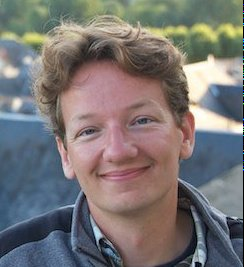This special guest post was provided by Dr Eelco Doornbos, a researcher at the Delft University of Technology, The Netherlands. Dr Doornbos works on the faculty of Aerospace Engineering, and his work includes converting GOCE data into observations of air density and wind speed in the upper atmosphere.
The foreword was provided by GOCE Mission Manager Dr Rune Floberghagen.
The fact that GOCE kept functioning so well for nearly the entire de-orbiting phase opens exciting new science opportunities as illustrated by this blog entry. ESA will make sure all data relevant to the investigation of this phase are made readily available to the scientific community as soon as possible. Likewise, we will use these data to further investigate the re-entry dynamics and modelling.
– RF

Photo of GOCE reentering the atmosphere taken by Bill Charter in the Falklands at 21:20 local time on 10 November.
Dr Eelco Doornbos, TU Delft
I am very excited to learn that GOCE has continued to send back measurements at very low altitudes until just hours before its reentry. The accelerometer measurements will be especially interesting. We will convert these to information on the atmospheric density and wind speed, using an aerodynamic model of the satellite.
The resulting density and wind information is used to improve models of the upper atmosphere. These models are used in the design of future space missions, and in mission operations, for example to prevent collisions between satellites and space debris.
At the start of the mission, at 270 km, GOCE was already the lowest flying satellite to provide detailed acceleration data.
A couple of days before re-entry, below 180 km altitude, the accelerations occasionally started to become too large for the very sensitive instrument. Additional acceleration measurements, although with more and more such outages, were made down to 150 km. Information on the accelerations with a lower resolution and precision will be retrieved from the satellite’s GPS receivers as well. The precise GPS data were last received from an altitude of around 130 km.
You can imagine that it is very difficult to get measurements at these altitudes, because most satellites will not be able to operate there like GOCE did, and even GOCE only passed through the region within a very short time span.
The aerodynamic analysis of the data might be difficult, because the satellite was transitioning through different aerodynamic regimes. The effort will be worth it, because this altitude range is scientifically interesting for many reasons. For instance, the extreme ultraviolet sunlight which drives the variability of density at higher altitudes is absorbed here. We hope to gain insight in how weather patterns in the lower atmosphere influence the upper atmosphere when atmospheric waves pass through this region as well.
A final application of this unique data set is in re-entry modelling. The GOCE re-entry was already modelled before its launch, so that we knew more or less what to expect yesterday. The results of that modelling effort can now be compared with accurate data, so that we can try to improve the modelling for future re-entries.


Discussion: no comments